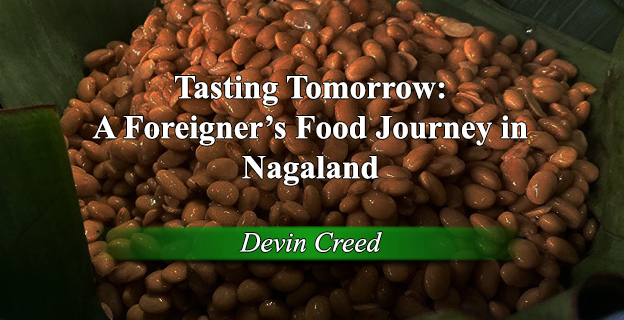“Two summers ago I even brought axone back to the US from Nagaland’s Kitchen in Delhi and forced my American friends to eat my version of pork axone”

On the fourth day of fermentation I unwrapped the banana leaves covering my nascent axone and was greeted by a horrible sight. My soya beans had developed a little mold, but my black-eyed pea experiment was teeming with wriggling maggots. In my haste to get the experiment underway I had not properly sealed my axone, and thus had ushered in hundreds of tiny visitors to my Kolkata apartment. I binned my experiments in disgust; though I have been fermenting at home for nearly a decade, I had still managed to botch my first attempt at axone.
My ill-fated attempt at making axone was a part of my participation in the global project Tasting Tomorrow, which examines the effects of climate change on traditional recipes. The brainchild of artist and philosopher Jonathan Keats, the project seeks to preserve traditional recipes by determining how they can be adapted to changing climate conditions. The project uses the method of climate analogue modeling; envisioning the future climatic conditions of a given region by looking at current climatic conditions in other regions. For instance, Keats and researchers in Kohima have determined that Nagaland’s climate analogue is the Lower Dir District of Pakistan. This means that at some point in the near future, Nagaland’s climate will look much like Lower Dir District’s climate does now.
Climate-adapted cooking seeks to use these insights to determine how traditional recipes can be adapted to the changing nature of local crops due to climate change. For Nagaland, this means seeing how common crops and foods from Lower Dir District can be incorporated into common Naga dishes. Researchers at The Highland Institute in Kohima have been experimenting with introducing these ingredients into Naga cuisine since last year.
These ingredients have included millets, jalapenos, and black-eyed peas, among others. Tasting Tomorrow was the impetus for my failed attempt at making axone out of black-eyed peas mentioned above.
I was grafted onto this project because I am a historian of food in South Asia, as well as an aspiring chef. My current research project examines how famine changed the way people eat in Bengal and North India over the last two hundred years, but when I was given the opportunity to participate in a project on Naga food, I jumped at the chance. I have enjoyed Naga food for years, despite never visiting Nagaland itself until last year. I used to live near Humayunpur in Delhi, and would often frequent the Naga restaurants there, as pork is my favorite meat (a preference I cultivated during the year I spent living in South Korea). Two summers ago I even brought axone back to the US from Nagaland’s Kitchen in Delhi and forced my American friends to eat my version of pork axone. I roughly followed a short youtube video and the resulting dish was pungent but edible; my friends quickly gobbled it up.
In November 2023 I flew to Dimapur from my home in Kolkata to begin a ten-day jaunt through Nagaland. While the nominal purpose of my trip was to host a workshop on Naga food with anthropologists at The Highland Institute in Kohima, I also wanted to familiarize myself with local geographies and foodways. I spent time in Dimapur, Kohima, Jotsoma, Khonoma, Kigwema, Zhakama, Viswema, and Khuzama, usually staying in homestays. I sampled a variety of Naga dishes such as poknüng aon, smoked pork with anishi, beef galho, pork with bamboo shoot, blood sausage, pork intestine, and kholar. I realize that I only scratched the surface of what Nagaland has to offer culinarily, as I mostly visited Angami villages and ate Angami food. This brief taste of Naga cuisine and hospitality quite literally left me hungry for more.
After traveling around the region for a week, I returned to Kohima to prepare for the workshop. My collaborators, anthropologists Akumtong Imchen, Tümüzo Katiry, and Saktum Wonti, and I prepared the dishes we would serve the following day, which were meant to spur discussion among the participants. The workshop was themed around the past, present and future of Naga food, so we prepared a historic dish (a kind of boiled corn tea), a dish that is often eaten today (beef galho), and a climate-adapted dish for the future (kholar, but replaced with black-eyed peas). For the galho, we brought in local cook Alebu Sekhose Sanchu to demonstrate how the dish is traditionally prepared. For the kholar, we made the traditional version as well as a version that substituted kholar with black-eyed peas. We wanted the workshop participants to comment on the differences between the two so we could assess the possibilities of black-eyed peas becoming a staple of Naga diets.
On the day of the workshop we began with a potluck meal consisting of rice, our three dishes, and various chutneys we had prepared using king chili and black-eyed peas. After eating, we discussed what we had eaten and posed questions about the changing nature of Naga foodways. The reaction to our modified kholar was mixed; some preferred the texture of the black-eyed peas while others vouched for the original. Regardless of taste, we determined that black-eyed peas could easily be substituted in the place of kholar, and they also performed admirably in our chutneys.
When we asked how participants had seen Naga food change in their lifetimes we noticed several interesting trends. Certain food items have fallen by the wayside, especially dog, cat, insects, lizards and worms. This has coincided with the growing popularity of Western, Korean, and Japanese foods. At the same time, traditional Naga foods like hornet larvae have become luxury items that fetch a hefty price in the market. Other traditional foods, especially fermented ones, have enjoyed a resurgence because of their purported health benefits. When Naga foodways are exported, their ‘exotic’ nature and heavy use of fermentation are cited in order to charge high prices. Naga restaurants in Delhi charge premium prices that are at odds with their counterparts in Dimapur and Kohima, not to mention at village homestays. Food habits have also changed, as the family meal has given way to eating out and eating with friends. It remains to be seen how climate change will affect these trends, but many signs point to a further acceleration of changes in foodways and deeper disruptions to traditional agricultural, production, and consumption patterns.
To say that my visit to Nagaland last fall caused me to fall in love would be trite, and also a bit untrue. I had already developed a palate for Naga food and have consistently sought out axone and king chili. I developed a passion for spicy food in my early twenties after living in rural South Korea for a year, where the prominent spice is red chili. After a bout of Covid in 2022 left me permanently congested, my passion for spice has become more of a necessity, as subtle flavors are now harder for me to appreciate. This is one of the reasons Naga food appeals so much to me; the tastes are big and bold, strong sometimes even to the point of being off-putting. The heavy use of animal fats brings the most out of the spices and aromatics used to enhance many dishes. The strong odor and taste of fermented staples like anishi and axone force the eater to pause and savor. Many Naga foods make you feel that you are eating something of consequence; it is a cuisine that lingers on the tongue and in the mind. It is a cuisine that I certainly cannot keep out of my mind as I plan my next axone experiment, which will, hopefully, not invite a horde of maggots into my home.
Author Bio:
Devin Creed is a Fulbright-Nehru scholar based in Kolkata. He is completing his PhD in South Asian History at Duke University (USA). He can be reached at devinacreed@gmail.com where he would love to hear about how he can improve his axone technique.



